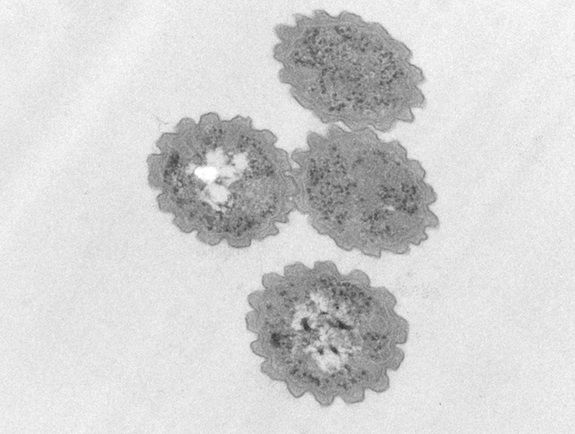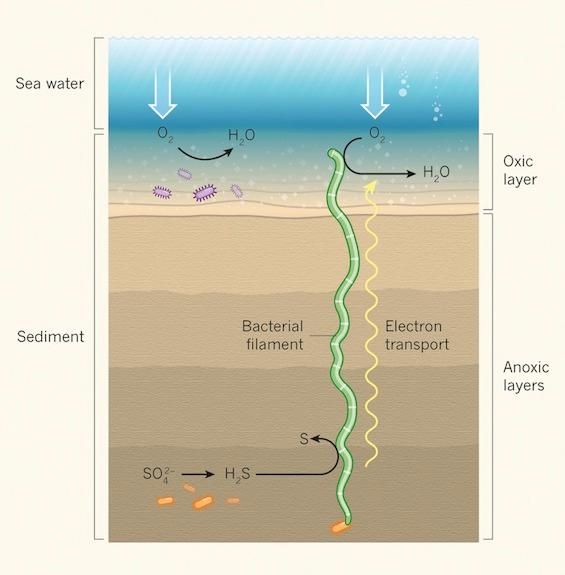Live Wires: Newly Discovered Seafloor Bacteria Conduct Electricity
Scientists have found ultrathin multicellular bacteria that create electrical circuits several centimeters long
/https://tf-cmsv2-smithsonianmag-media.s3.amazonaws.com/filer/20121025081123live-cables-bacteria-small.jpg)
Two years ago, microbiologist Lars Peter Nielsen of Aarhus University in Denmark was studying the mud on the seafloor of the city’s port when he discovered something unexpected: The mud was coursing with detectable levels of electricity. At the time, he and his colleagues suspected that the electric currents might be attributable to some sort of external transport network between individual bacteria or other microscopic organisms.
The truth, described in a paper published yesterday in Nature, is even more surprising. “Our experiments showed that the electric connections in the seabed must be solid structures built by bacteria,” PhD student Christian Pfeffer, the lead author of the paper, said in a press release. His team, working with researchers from the University of Southern California, found a new type of multicellular bacteria that behave like electrical cables, capable of conducting electricity over a distance of several centimeters, a far greater span than scientists had previously imagined.
The group discovered the bacteria, which belong to the Desulfobulbaceae family, by examining seafloor mud under a microscope. Because the bacteria are so small and fragile—one hundred times thinner than a human hair—there is no way to directly measure the electric current they carry, but the researchers found several types of indirect evidence that they do conduct electricity.
The bacteria are aligned vertically in the sediment, and when non-conducting tungsten strands were pulled horizontally across the bacteria, the bacteria short-circuited and the electric current was disrupted (like an excavator cutting through buried cables). Additionally, when filters were put in place to block the bacteria from growing, the electric current was shut down, unless the filter’s pores were large enough for the bacteria to grow through.
Remarkably, under a microscope, the bacteria look a bit like the cables used in electrical devices. Inside each bacterium, 15 to 17 distinct fibers run lengthwise, each capable of conducting electricity. The long fibers are made up of many connected cells, each only a micrometer long.

A natural question to ask is why bacteria would go to the trouble of evolving the unusual capability to conduct electricity. The answer might be as fascinating as the bacteria themselves. It turns out that just a few centimeters below the seafloor is a rich, largely untapped energy source: negatively charged sulfur atoms called sulfides.
The reason that most organisms are unable to harvest the energy from these chemicals is that the surrounding mud is largely devoid of oxygen. An energy-rich, electron donor food source is present, but organisms need oxygen to accept the spare electrons as part of the energy-harvesting equation known as respiration. It’s analogous to our need to both eat food (the sulfides) and breathe air (the oxygen) in order to survive.
The bacteria solve this problem by traversing the distance between their food and their oxygen source with a circuit capable of carrying electrons. At the bottom end, the organism harvests energy from the sulfides, then sends the electrons upward. At the top, near the oxygen-rich seawater, it is able to use the abundant oxygen available to conduct respiration.

As a result, the bacteria have only been found so far in anaerobic seafloor sediments—but in these environments, the research team found a staggering amount of them. On average, in each cubic centimeter of the sediment tested, they found 40 million cells of this type of bacteria, an amount they calculate could form 117 meters of the superthin conducting cable.
Although the organisms have tentatively been taxonomically placed in an existing bacteria family, the researchers say they are radically different from any other bacteria we’ve found so far. “They’re so different that they should probably be considered a new genus,” Nielsen told Ed Yong at Discover’s Not Exactly Rocket Science, noting that they only share 92 percent of their DNA with any other species in the family.
In the same piece, Nielsen also mused about the possibility that the heretofore undiscovered species might be much more ubiquitous than now known. “They seem to be the optimal organism in any place where you become short of oxygen. Why are they not everywhere?” Nielsen asked. “Or are they everywhere?”
/https://tf-cmsv2-smithsonianmag-media.s3.amazonaws.com/accounts/headshot/joseph-stromberg-240.jpg)
/https://tf-cmsv2-smithsonianmag-media.s3.amazonaws.com/accounts/headshot/joseph-stromberg-240.jpg)